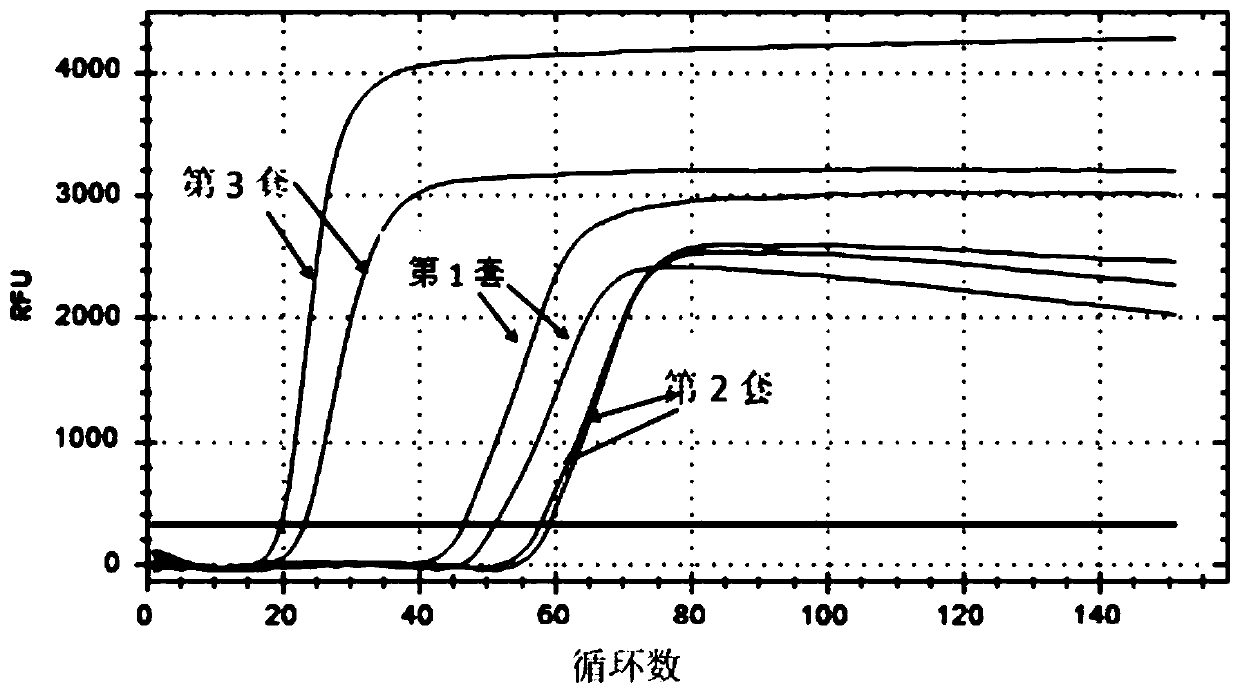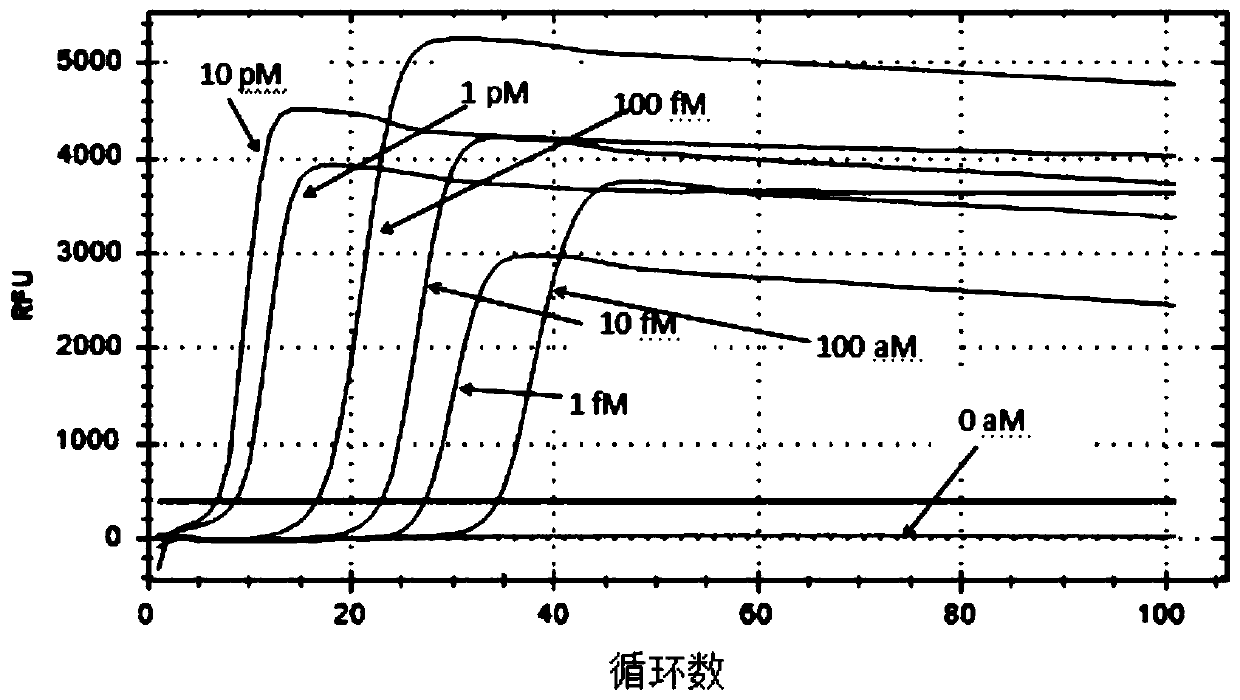Primer, reagent kit and method for detecting clostridium difficile
A Clostridium difficile and kit technology, applied in the field of molecular biology, can solve problems such as complex application, difficult sequence feature analysis, complex target sequence preparation, etc., to achieve the effect of avoiding sample cross-contamination and simplifying the operation process
- Summary
- Abstract
- Description
- Claims
- Application Information
AI Technical Summary
Problems solved by technology
Method used
Image
Examples
Embodiment 1
[0047] Example 1 Amplification and detection of Clostridium difficile toxin B gene tcdB
[0048] Use the tcdB plasmid DNA containing the toxin B gene as the detection target for screening the dominant primers.
[0049] Wherein, the conserved sequence of the toxin gene tcdB of Clostridium difficile is shown in SEQ ID NO:13.
[0050] SEQ ID NO: 13
[0051] TCTATTTCTGATGCACTATGTGACTTAAAACAACAGAATGAATTAGAAGATTCTCATTTTATATCTTTTGAGGACATATCAGAGACTGATGAGGGGTTTAGTATAAGATTTATTAATAAAGAAACTGGAGAATCTATATTTGTAGAAACTGAAAAAACAATATTCTCTGAATATGCTAATCATATAACTGAAGAGATTTCTAAGATAAAAGGTACTATATTTGATACTGTAAATGGTAAGTTAGTAAAAAAAGTAAATTTAGATACTACACACGAAGTAAATACTTTAAATGCTGCATTTTTTATACAATCATTAATAGAATATAATAGTTCTAAAGAATCTCTTAGTAATTTAAGTGTAGCAATGAAAGTTCAAGTTTACGCTCAATTATTTAGTACTGGTTTAAATACTATTACAGATGCAGCCAGAGTTGTTGAATTAGTATCAACTGCATTAGATGAAACTATAGACTTACTTCCTACATTATCTGAAGGATTACCTATAATTGCAACTATTATAGATGGTGTAAGTTTAGGTGCAGCAATCAAAGAGCTAAGTGAAACGAGTGACCCATTATTAAGACAAGAAATAGAAGCTAAGATAGGTATAATGGCAGTAAATTTAACAACAGC...
Embodiment 2
[0066] The reaction efficiency verification of embodiment 2 different primers
[0067] Preparation of an isothermal amplification reaction mixture, wherein the reaction mixture contains Mg 2+ The concentration is 8mM; K + The concentration is 6mM; NH 4 + The concentration is 10mM; H + The concentration is 20mM; Cl - The concentration is 6mM; SO 4 2- The concentration of Tris-HCl is 10mM; the concentration of Tris-HCl is 20mM; the concentration of Triton X-100 is 0.01g / mL; the concentration of dNTP is 1.4mM; the concentration of thymine DNA glycosylase is 50U / mL; The concentration is 320U / mL; the primers shown in P1 in Table 1 are 0.2 μM, the primers shown in P2 are 0.8 μM, the primers shown in P3 are 0.2 μM, and the primers shown in P4 are 0.8 μM, and SYBR Green I is a real-time fluorescence analysis dye . Use 3 sets of primer mixtures with 3 sets of primers configured after design, screening and comparison, use tcdB plasmid DNA at a concentration of 10 fM as the det...
Embodiment 3
[0068] Example 3 Reaction Sensitivity Verification
[0069] As described in Example 2, the amplification detection mixture and the primer mixture configured by the third set of primers were amplified and real-time fluorescently detected under the conditions of 63°C and 90min for real-time fluorescence curves of different concentrations of tcdB plasmid DNA, each concentration in turn It is 10 pM, 1 pM, 100 fM, 10 fM, 1 fM, 100 aM, 0 aM. Use a real-time fluorescent quantitative PCR instrument for detection, and read the fluorescence value every 30s. For the real-time fluorescence curve of the specific results, please refer to the attached image 3 . The real-time fluorescence curve shows that the concentration of tcdB plasmid DNA can be detected as low as 100aM in this example, indicating the high sensitivity and extremely low detection limit of the method of the present invention.
PUM
| Property | Measurement | Unit |
|---|---|---|
| concentration | aaaaa | aaaaa |
Abstract
Description
Claims
Application Information
 Login to View More
Login to View More - R&D
- Intellectual Property
- Life Sciences
- Materials
- Tech Scout
- Unparalleled Data Quality
- Higher Quality Content
- 60% Fewer Hallucinations
Browse by: Latest US Patents, China's latest patents, Technical Efficacy Thesaurus, Application Domain, Technology Topic, Popular Technical Reports.
© 2025 PatSnap. All rights reserved.Legal|Privacy policy|Modern Slavery Act Transparency Statement|Sitemap|About US| Contact US: help@patsnap.com



